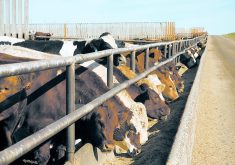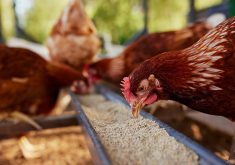Long-awaited review of country’s feed rules offers industry more flexibility, risk-based approach, focus on food safety
Glacier FarmMedia – Canada’s feed industry has a new set of rules.
The Canadian Food Inspection Agency has released its long-promised update to national feed regulations. Formally referred to as “Feeds Regulations, 2024,” the final version was registered June 17 and published July 3 in part 2 of the Canada Gazette.
“We’ve been waiting for this for over 14 years to get to where we are today,” said Melissa Dumont, executive director for the Animal Nutrition Association of Canada.
Read Also

Gene editing digs deeper space in Canadian plant breeding
More Canadian research into crop variety development is incorporating gene editing, and one researcher notes that Canada’s regulatory approach to gene editing will help drive innovation
The new requirements will be introduced gradually. Labelling rules and compositional and safety standards came into effect July 3, with a one-year transition period during which industry can follow either the existing or new rules.
Other changes now in force include mink and fox removal from the definition of livestock, approval and registration requirements, feed content standards, rules around feed for export, risk investigation procedures, record-keeping requirements and exceptions noted in both the Feeds Regulation, 2024 and the Feeds Act.
All other rules will have a staggered rollout over the next 18 months, according to the CFIA website.
New complaint procedures, rules around recalls and packaging, regulations on imported feeds, traceability requirements and hazard assessments and preventive controls/control plans will be in the next wave, coming into force in June 2025.
Licensing requirements, export documentation, rules around import of a non-compliant feed and the new scope of livestock species will be in the final parts of the regulations, scheduled to come into force in December 2025.
The animal nutrition association asked the CFIA in 2010 to modernize feed regulations to better reflect current industry realities. It said there had been significant developments in animal nutrition knowledge, technology and customer requirements in the previous decades and it was time for the regulatory environment to catch up.
The 2024 regulations include a range of new and updated requirements touted to improve the safety of livestock feed, reflect international best practices, improve food safety and support innovation within the animal feed sector. The CFIA said they will provide a transparent process for approval and regulation of feed ingredients and feed products.
“There are a lot of benefits that have come out of the new regulations,” said Dumont.
The previous regulations were last reviewed in 1983, including nutrient minimums and maximums and safety levels. She said the new document is more flexible, allowing for easier change.
“One of the main things (about the new regulations) is that many of the documents are incorporated as reference. They’re still part of the law, they are referenced in the regulations, (but) they sit outside of the regulations. Through consultation processes, these documents can now be updated based on new science as it becomes available.”
Dumont said the regulations will change some of the products that require authorization, which will increase focus on a safety and risk-based approach. She also expects they will improve trade opportunities.
Nutrient requirements also got a modern polish.
“The minimum nutrient requirements were very old, and some of them actually required us to put too many nutrients in the feed,” Dumont said.
“The law was requiring us to do that. This has now given us that flexibility and it also takes, again, that risk-based approach by requiring feed businesses to have preventive controls in place, so to prevent risks and hazards as they occur, as opposed to dealing with them once they occur.”
Most farms will not be required to have preventive controls. That aspect of the regulations doesn’t apply to those who produce non-medicated feed. Farms that mix medications into feed on-site will have to meet the regulatory standard, due to food safety concerns connected to medication residue in animals.
If a farm has multiple species, is making its own feed and uses many different medications, it may need more complicated preventive controls.
“One of the changes is that we will be able to use veterinary health products in mixed feeds,” said Dumont. “If any company notifies veterinary health products to Health Canada and it goes through the process for approval, we will then be able to mix it in feed as long as it’s been approved for use in feed.”
Dumont said she hopes the new rules will reduce the regulatory burden on producers. Much of that burden was not risk-based or food-safety-based, she added.
The CFIA has published guidance on the new rules and the nutrition association is working with national producer groups to develop educational material.
The CFIA has scheduled two information sessions on the new rules, one in English on July 24 and another in French July 22.
The association has its own voluntary certification program called FeedAssure, which meets the preventive control requirements in the regulations, Dumont said.
















